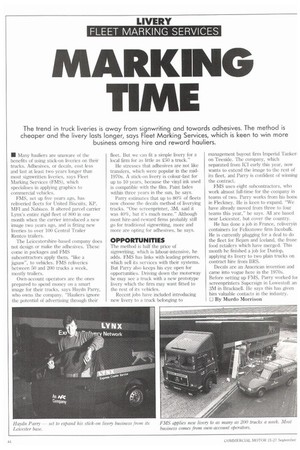MARKING TIME
Page 46

If you've noticed an error in this article please click here to report it so we can fix it.
The trend in truck liveries is away from signwriting and towards adhesives. The method is cheaper and the livery lasts longer, says Fleet Marking Services, which is keen to win more business among hire and reward hauliers.
• Many hauliers are unaware of the benefits of using stick-on liveries on their trucks. Adhesives, or decals, cost less and last at least two years longer than most signwritten liveries, says Fleet Marking Services (FMS), which specialises in applying graphics to commercial vehicles.
FMS, set up five years ago, has reliveried fleets for United Biscuits, Kt', MFI and Nabisco. It altered parcel carrier Lynx's entire rigid fleet of 800 in one month when the carrier introduced a new image two years ago, and is fitting new liveries to over 100 Central Trailer Rentco trailers.
The Leicestershire-based company dues not design or make the adhesives. These come in packages and FMS subcontractors apply them, "like a jigsaw", to vehicles. FMS reliveries between 50 and 200 trucks a week, mostly trailers.
Own-account operators are the ones prepared to spend money on a smart image for their trucks, says Haydn Parry, who owns the company. "Hauliers ignore the potential of advertising through their fleet. But we can fit a simple livery for a local firm for as little as £50 a truck."
He stresses that adhesives are not like transfers, which were popular in the mid1970s. A stick-on livery is colour-fast for up to 10 years, because the vinyl ink used is compatible with the film. Paint fades within three years in the sun, he says.
Parry estimates that up to 80% of fleets now choose the decals method of liverying trucks. "One screenprinter, 3M, said it was 40%, but it's much more." Although most hire-and-reward firms probably still go for traditional signwriting, more and more are opting for adhesives, he says.
OPPORTUNITIES
The method is half the price of signwriting, which is labour-intensive, he adds. FMS has links with leading printers, which sell its services with their systems. But Parry also keeps his eye open for opportunities. Driving down the motorway he may see a truck with a new prototype livery which the firm may want fitted to the rest of its vehicles.
Recent jobs have included introducing new livery to a truck belonging to management buyout firm Imperial Tanker: on Teeside. The company, which separated from ICI early this year, now wants Lo extend the image to the rest of its fleet, and Parry is confident of winning the contract.
VMS uses eight subcontractors, who work almost full-time for the company in teams of two. Parry works from his horn( in Fleckney. Ile is keen to expand. "We have already moved from three to four teams this year," he says. All are based near Leicester, but cover the country.
He has done a job in France, reliveryin containers for Felixstowe firm Incobulk. He is currently plugging for a deal to do the fleet for Bejam and Iceland. the froze food retailers which have merged. This month he finished a job for Dunlop, applying its livery to two plain trucks on contract hire from BRS.
Decals are an American invention and came into vogue here in the 1970s. Before setting up FMS, Parry worked foi screenprinters Supersign in Lowestoft an 3M in Bracknell. lie says this has given him valuable contacts in the industry. CI By Murdo Morrison




























































































































































